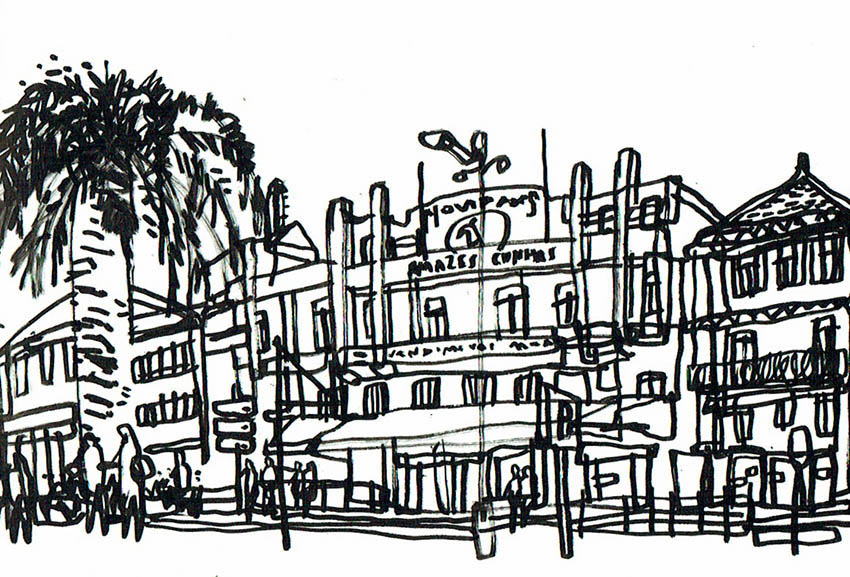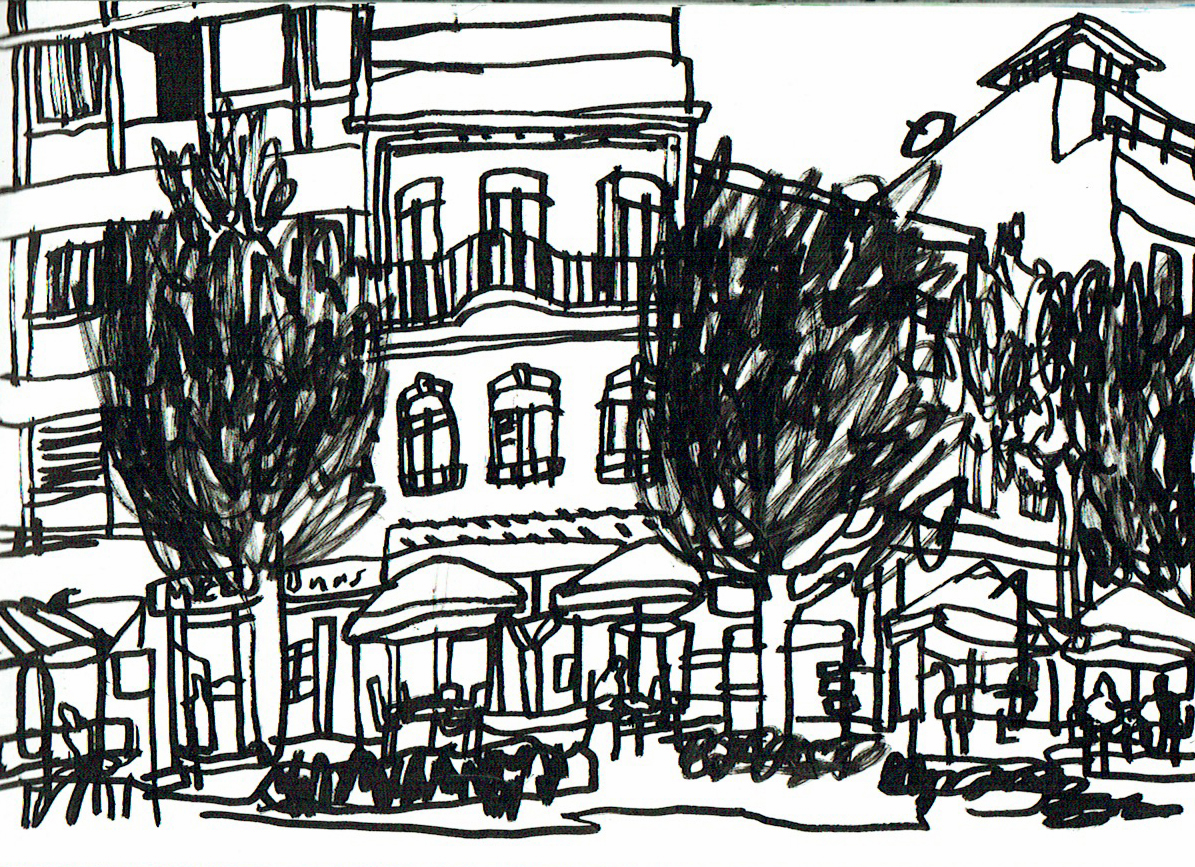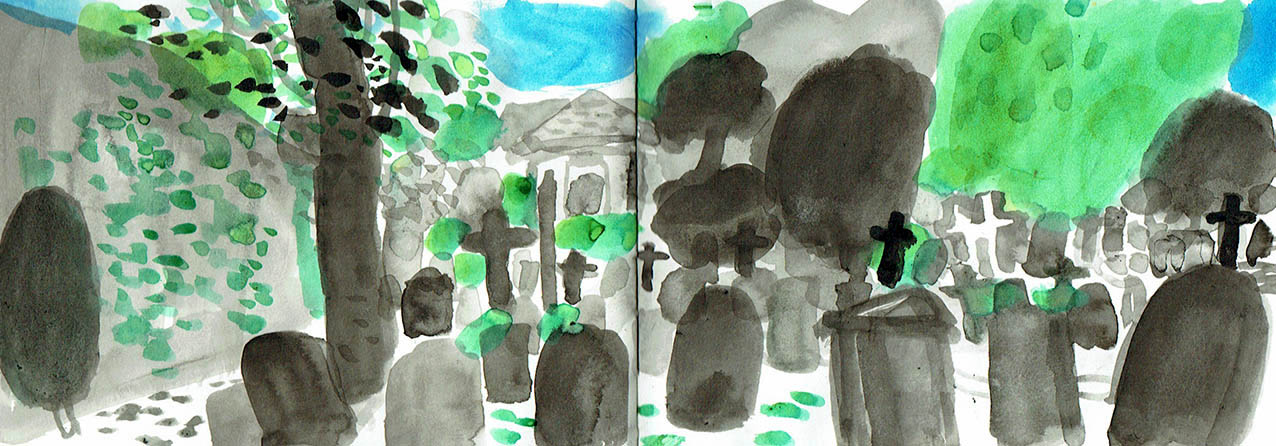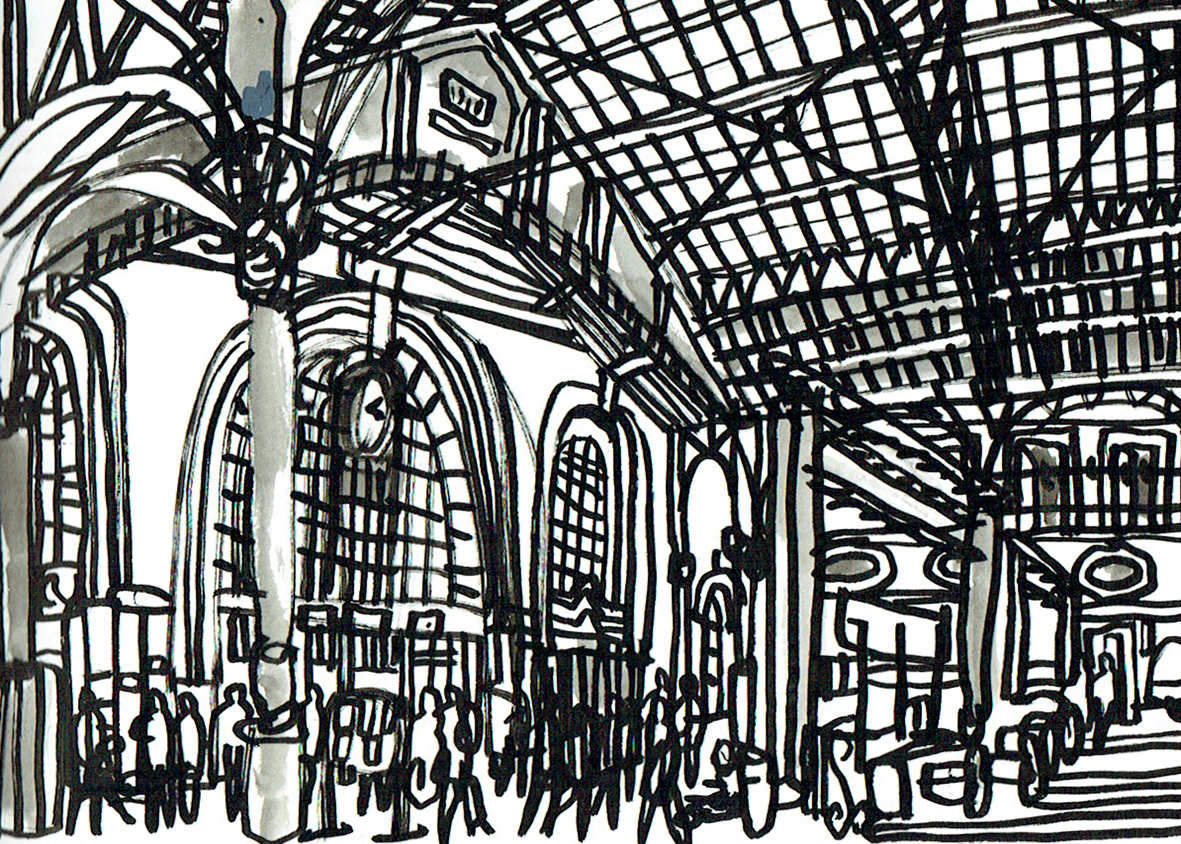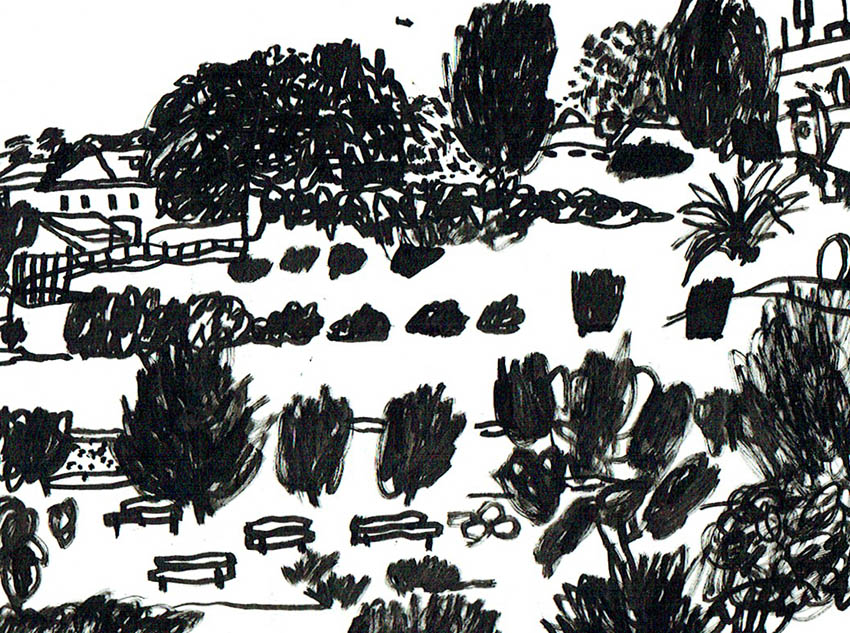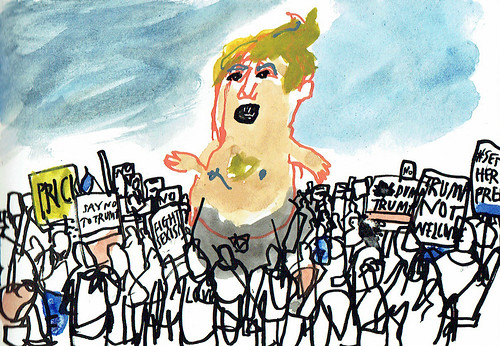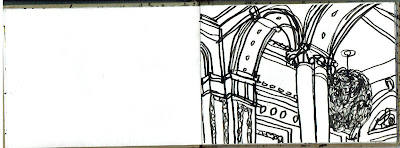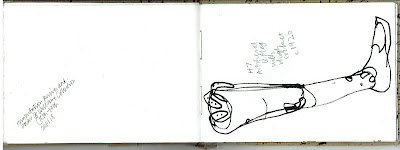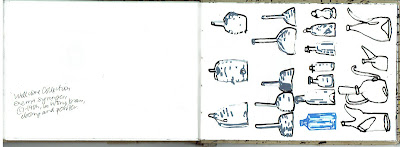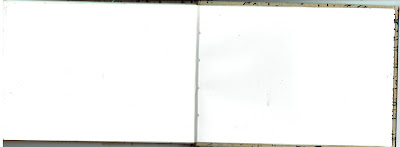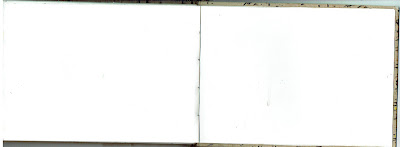Monday, 10 December 2018
In the pages of Manchester Sketchbook 2
Two of my drawings, I am happy to say, are included in the new book Manchester Sketchbook 2, which features the work of 36 artists from around the world who took part in the Urban Sketchers symposium in the city in the summer of 2016. Copies of the book – and the first Manchester Sketchbook – are on sale via the website of Simone Ridyard. My thanks to Simone for inviting me to have my work included in it.
Saturday, 1 December 2018
Out now in The Artist
The January 2019 issue of The Artist magazine includes an article by me about how sketchbooks are laboratories for experimentation and play, and not necessarily places to make pristine works that aim to garner likes on social media. Our most "liked" works aren't always the ones leading us in the best direction.
Thanks to Isabel Carmona, Liz Loxton, Swasky and Lis Watkins, whose works are featured in the article.
Thanks to Isabel Carmona, Liz Loxton, Swasky and Lis Watkins, whose works are featured in the article.
Monday, 19 November 2018
On letting go
I've often thought that the process of drawing has similarities with the ups and downs of form experienced by sportspeople. Sometimes things flow effortly, and then at other times it can seem like hard work, when nothing goes as you'd hoped. I was reminded of this while reading On Cricket, a new book by the former England captain and psychoanalyst Mike Brearley. A passage in it refers to playfulness and losing inhibitions:
"... I think that writing, like playing cricket, like, in fact, many activities of life, involves at best a benign sort of marriage between discipline and spontaneity, between hard work and playfulness, between letting go of conscious control and the application of sometimes critical thought."
Of course, it doesn't always work out as you'd like. The playfulness can easily come unstuck. In terms of drawing, that is what sketchbooks can be for: an arena for coming unstuck and being spontaneous, and occasionally, sometimes (and not necessarily in the images included here) an uninhibited zone where you can happily surprise yourself, buoyed up by all that experience, hard work and discipline. And not mind whether they gather two likes on social media or two thousand.
From the top: the view from the top of Tate Modern looking towards Blackfriars Bridge, three scenes from a moving train going to the Midlands from London, and Cornelia Parker's Transitional Object (PsychoBarn) in the courtyard of the Royal Academy, London.
Wednesday, 3 October 2018
Postcards in Tate Library
In the latest example of things I have made heading off into the world and having a life of their own, a set of four postcards of my drawings and other items relating to an exhibition of my work at Wolseley Fine Arts, London, in February 1996 are now in the Tate Library at Tate Britain. In 1990, I spent six months drawing my way around England, culminating in that show.
Clockwise from top left: Ludlow Boots; the spires of Shrewsbury; Saxon Church, Bradford on Avon; Roman Baths, Bath.
Thursday, 30 August 2018
Five days in Porto
I didn't get any drawing done on my first day in Porto. That was partly because it was a new city for me, and I was always left wondering what was around the next corner, and partly because it was a day for meeting and talking with people that I rarely, if ever, get to meet in person. To walk along by the river Douro that day was to bump into a stream of familiar friendly faces to greet (Elizabeth Alley, James Richards, Marissa Swinghammer, Melanie Reim to mention a few), which, being in a foreign land, is an odd sensation.
The ninth Urban Sketchers symposium (18-21 July 2018) was a bit like the gathering of the clan: around 800 people from more than 40 countries who draw on location descended on the city for the four days (although most, it seemed, arrived earlier or stayed later, or both). Everywhere you turned there was someone drawing, or people sharing their sketchbooks, or throwing their arms around an old mate.
Perhaps the talking was more important than the drawing (below I post some of my drawings from the five days I was in Porto). Within an hour of arriving in Porto I was meeting with the rest of the lovely USk editorial team: we work together on the international blog, communicating almost daily by email, but never as a complete group in person. We still weren't all present (Marcia Milner-Brage and Murray Dewhurst were missed), but it was close. (Image left to right: me, Gabi Campanario, Suhita Shirodkar, Béliza Mendes, USk president Amber Sausen, and Tina Koyama. Photo courtesy of Tina.)
This was the moment when I finally got to meet Gabi, the founder of USk, someone I consider an old friend, but who I had never met before. We first exchanged emails nearly ten years ago when I heard about Urban Sketchers. I'm proud to have had my drawings featured in his books, and he has kindly agreed to be in mine. Truth be told: finally getting to meet and spend time with Gabi was a much-anticipated highlight of my Porto days.
The remaining days were a rush of meeting old friends, making new ones, staying up too late, laughing over dinner, wondering how Porto is going to manage with the huge influx of tourists that we were part of, and drawing, drawing, drawing. There are too many names to even begin mentioning them here, but it was great being with you all. Happy days.
Some drawings:
Rua Chã, Porto: an alleyway I'd pass each day on my walk between the hotel and symposium centre.
Armazéns Cunhas department store, Porto.
Praça a Guilherme Gomes Fernandes, Porto.
St James's British cemetery, Porto: a group of us jumped into a minibus and spent a cooling morning drawing there. An entertaining lunch with Stuart Goss and Joaquim Espadaneira followed.
São Bento railway station: the Friday afternoon sketchwalk.
The view from the steps of São Bento railway station.
Virtudes garden, Porto: the Saturday morning sketchwalk.
Igreja dos Carmelitas and Igreja do Carmo, Porto. I drew this one to replace one of the same subject that was sold to Richard Briggs in the last evening's silent auction. Thanks, Richard.
City Hall, Avenida dos Aliados, Porto: the big final sketchwalk on the Saturday afternoon. Beneath this, out of sight, are around 800 people busily drawing.
From Rua de Ferreira Borges, Porto, looking east, with the cathedral in the background.
The House of Sandeman, across the river Douro, with the cable car that runs between the bridge and the waterfront.
Next year, it's all happening in Amsterdam.
Monday, 13 August 2018
What I did when we went to Switzerland
Our first few days in Flims in eastern Switzerland passed just as we planned them, revisiting places where N had holidayed with her family when she was a small child. We swam in lakes, hiked through forests, and picnicked in Alpine meadows. Even on the fourth day, when I was feeling under the weather with a stomach ache, we managed a gentle 10km downhill walk to a viewing platform over the Rhine Gorge and a visit to another lake. But I lay and slept at every moment I could, and didn’t open the sketchbook all day.
By the evening, the nature and location of the ache had changed, and I soon found myself, along with N and daughter 2, in an ambulance heading to Chur, the nearest city. Swiss medical care, I discovered, is everything it is cracked up to be. Within a few hours appendicitis had been confirmed, and by the early hours I was being wheeled into surgery for an emergency appendectomy. “What kind of holiday is this?” I remember asking the anaesthetist.
I came round in a small ward with the most phenomenal Alpine view of the Calanda mountain, which I soon felt well enough to draw from my bed (top image, above and bottom image). It’s hard to say what the medical benefits may be of having such a view beside you as you recover from surgery, but this, as well as the neat laparoscopic surgery, fantastic nursing care, and excellent cuisine, meant I was soon feeling much much better. I drew it again, several times, along with the view at the bottom of my bed.
The act of drawing somehow felt more important to me than the end result. My roommate was better than I show him: I left for the flight home to London the following day, and he was expecting to leave soon after. We had no common language but we’d exchange cheerful thumbs-ups and smiles. He proudly showed me a press cutting about the construction site accident that had brought him to hospital. You could tell we were both very aware that if we had to experience what we were going through, we were bloody lucky to be where we were.
I’m home now, back at work, feeling so much better, and very grateful, thanks for asking.
[This post is also published on the Urban Sketchers blog.]
Monday, 16 July 2018
When Trump came to London
When US president Trump came to London last week I found time to join the demonstrating crowds at Parliament Square. Like other demonstrations I have attended, it was impossible not to be drawn into its good-natured humour, and its combination of frank and understated responses delivered through banners and placards. There were a lot of people from the US attending too, from either side of the Trump divide, some hoping for his 2020 re-election, and some professing shame and embarrassment at what they see their leader as standing for.
I drew the scene, quite quickly, and posted it on Instagram, along with a simple description of where I was, and what I had drawn. I readily admit it isn't a great drawing – I found myself caught between two columns of marchers as they passed from Whitehall into the square, and so conditions were a little cramped – but in the spirit of the moment I shared it online within minutes of doing it. The symbol of the day, the inflated Baby Trump blimp, and the focus of my drawing, was more orange than I show it, but it had passed quickly, and was then lost in the melee. I had time for one drawing to capture the event, and this was it.
My Instagram images had never before been reposted by the official Urban Sketchers feed, and I had no expectation of this one being shared with its 155,000 followers, so it came as a surprise when it was. The response from my own much more modest number of followers was supportive and even enthusiastic. On the USk shared post it was less so. There seemed to be a feeling that while images of a political nature were fine for Facebook, Instagram was for drawings of a more refined nature. "Leave this shit to FB PLZ," and "If @urbansketchers starts getting political, I’m gone," were among the much-liked responses.
I know perfectly well that my Trump blimp drawing fits exactly into the Urban Sketchers manifesto, so I make no apologies for that. And my drawing was free of any information about my own feelings about Trump, which I'll leave you to successfully guess at. I was most interested to find out that Instagram is considered a contention-free channel, and that Facebook is instead the place for the political stuff. (I'm on Facebook, mainly because I have overseas friends, and books to publicise, but I generally don't engage with it, particularly since its well-publicised record of carelessness with its users' data and involvement with Cambridge Analytica.) More than that, it was suggested by some that Urban Sketchers was not a place for reportage to be shared or reposted.
Most of my drawings are not overtly political, but the occasional one is. It would have been odd for me to have been in central London on Friday 13 July 2018 and not drawn the Trump blimp and the demonstration, just as it would have been weird not to have drawn the collapse of the wall in Berlin on 9 November 1989 or the Civil Rights march in Washington on 28 August 1963. Anyhow, here are a couple more politically related drawings of mine.
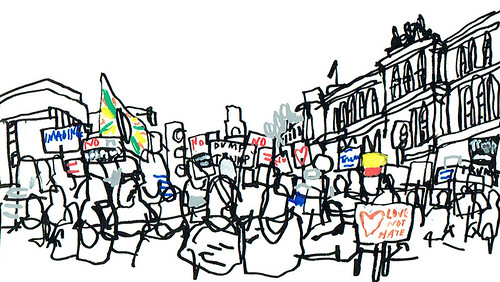 |
| Anti-Muslim travel ban march, Whitehall, London, 4 February 2017 |
 |
| Jeremy Corbyn arrives at Union Chapel, Islington on the eve of the 2017 General Election |
I'm off to pack for Porto now.
Friday, 1 June 2018
More scenes from a train
When I'm booking my train ticket and I'm asked whether I have any seating preference (in a quiet carriage, forward facing, that sort of thing), it is only the next-to-a-window option that I go for. From the window of a train there is the time and space to project yourself into an endless theme of changing environments. And it is this view that I find much more interesting to draw than fellow passengers and the backs of seats.
It is exactly because the view is so constantly shifting that it is an interesting subject to draw. The narrative unfolds as you look. The sense of place is less focused and yet unmistakable: the landscape between London and Devon, and London and the East Midlands (the routes I draw most) are mainly rural, agricultural, with occasional long views to distant horizons. It's a character or an essence that is there to be drawn, rather than a likeness. Looking at it mathematically, if the train is travelling at 120mph, and I'm taking three or four minutes to draw each image (these are mostly in open A6 sketchbooks), then they can be an amalgam of about six to eight miles of landscape.
The whirring view gives the opportunity to be brief, immediate, stabbing and imaginative rather than be bogged down in the dullness of likeness. Here are a few I've done recently.
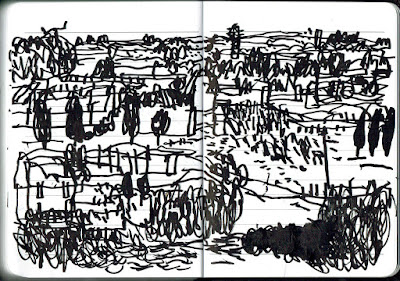 |
| London Paddington to Exeter St Davids, May 2017 |
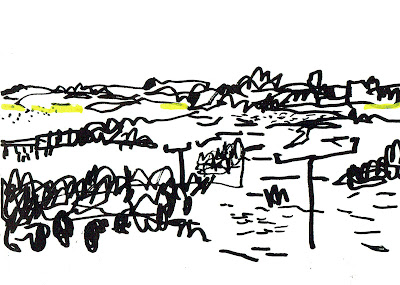 |
| Rapeseed fields near Kettering, May 2017 |
 |
| (Above and top image) London Paddington to Exeter St Davids, May 2018 |
 |
| Between Taunton and Exeter, June 2013 |
 |
| Between Taunton and Exeter, June 2013 |
 |
| London Paddington to Exeter St Davids, May 2018 |
 |
| London Paddington to Exeter St Davids, 2017 |
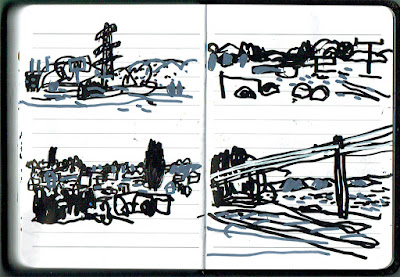 |
| Outside Luton, February 2018 |
 |
| Near Tiverton Parkway, the day Mum died, 17 August 2013 |
I've posted about drawing from trains before: From a train along the River Exe and Scene from a moving train.
Thursday, 26 April 2018
London's squares: Tavistock and Cavendish
With the onset of spring, I've found myself lazing in London's squares more than once. These two drawings show Cavendish Square (above), handily placed behind John Lewis on Oxford Street for post-consumerist recovery, and Tavistock Square (below), which is one of many lovely Bloomsbury squares close to where I have been working at the UCL Institute of Education.
I've written a longer post about five of London's squares on the Urban Sketchers blog.
You can follow me on Instagram and even Flickr.
Sunday, 22 April 2018
Stephen Lawrence's memorial, London SE9
Bus stop H on Well Hall Road, Eltham, in south-east London, isn't hard to find. It's by a roundabout on a busy residential road where the two teenagers Stephen Lawrence and his friend Duwayne Brooks were waiting for a bus when they were attacked by racist thugs 25 years ago this weekend.
A memorial to Lawrence, which is set into the pavement, is harder to find. I have to ask four people before they can tell me where it is, several hundred metres along the opposite side of the road next to a large London plane tree and a letter box. The distance somehow communicates their fear that night, the effort Lawrence went to escape the attack before he collapsed and died from knife wounds while the police stood over him offering no medical assistance. Three bunches of fading flowers and a bottle of non-alcoholic malt drink have been left by the stone.
The murder led to an inquiry into the way the Metropolitan police responded to the case, resulting in the force being branded institutionally racist, exposing a botched investigation and corrupt police, and leading to a change in the double jeopardy law, a revolution in UK police practice in relation to race, and eventually to the conviction, 18 years later, of two of the five suspects.
There's a low bench across the road from the memorial where I sit to draw. The view is eventually obscured by a hearse and people arriving for a funeral service at a nearby church. It seems a respectable street, with people out gardening and decorating in the spring sunshine, but extreme right wing BNP candidates are standing in next month's local elections here, and will get support. I draw in the square sketchbook with its detachable pages (top image), and then in the A5 hardback across a double page (above).
Back down the road, before I cycle home, I draw the bus stop where it all started, and, for Lawrence, ended.
I don't know why this feels important, but Lawrence liked to draw, and hoped to be an architect.
Wednesday, 28 March 2018
Outside Cambridge Analytica and Facebook
It is only a five-minute walk between the Cambridge Analytica HQ in New Oxford Street (above) and the newly opened Facebook offices in Rathbone Square (below). Following reports in the Guardian that Cambridge Analytica harvested the data of 50 million Facebook users without their permission to build a system that could target US voters in the presidential election, and had links to Leave groups in the Brexit referendum, the press had descended.
There is a handily placed cafe across the street from the Cambridge Analytica HQ: from it there's a good view (buses permitting) of the media scrum waiting for a warrant to be served so the premises could be searched by data watchdogs. I drew from the cafe window alongside two weary trainee journalists – out of place among the tourists and the shoppers – who had been sent to watch and wait.
By the time I got to draw the Facebook offices a few days later, the warrant had been granted, and Cambridge Analytica's offices had been searched. There is a pristine newness about the Facebook complex, and the surrounding retails units are still being fitted out. While the company's share price fell, there was no media presence here and nothing to suggest it was anything other than business as usual.
I've always had an uneasy relationship with Facebook, and although I have deleted my account before, I'm currently still on it. Interacting through Facebook involves sharing your data with what is, in effect, an advertising company, and that will always involve give and take. Except with the arrival of Trump and Brexit, it seems to me that there has been too much take.
Friday, 9 March 2018
Inside one unfinished sketchbook
I'm back from a visit to Elisa Alaluusua's exhibition at the Art Space Gallery, not far down the road in Islington. The show features videos of four artists talking about their sketchbooks undertaken as part of her PhD research into sketchbooks. The camera is generally trained on the books as the pages are turned and the artist talks about what each contains and their working processes. (In the circular way that these things can work, I interviewed Alaluusua for my own research into sketchbooks.)
Some artists, as we know, discard their sketchbooks when they are filled: by that point they are considered to have fulfilled their purpose. I'm not one of those people. I have shoe boxes stuffed with sketchbooks on the top of book shelves in a way that would cause sleepless nights for the health and safety executive. Closer at hand and on a lower, safer level are more recently completed and current sketchbooks.
My current A5 sketchbook (shown above) is nearly full: a few empty double pages remain at the end. Seeing Alaluusua's videos makes me wonder what I would say about it, should her camera be peering over my shoulder. The book covers the months following the end of October 2017: drawings done wherever I find myself with time to draw, but also some done on a few gatherings meeting up to draw with other artists, and some done for an NBC News report. There's nothing very special about the sketchbook: it's usual in that some drawings work and some don't, some surprised me in how they turned out, and some disappoint, some I immediately disliked and am now keener on, and some are declining in my estimation. As if that matters.
What makes it stand out, for me, anyway, is that it is one of four made by my younger daughter and given to me as a Christmas present. There's a note from her inside the front cover to mark this. It's what helps me to mark this one out from all the others I have done over 30-odd years.
Usually I show an image or two from a sketchbook, but here I've scanned and shared the lot. I've included scans of the blank pages. I found in my research that digitised sketchbooks that missed out the apparently untouched folios seemed to be keeping secrets. Even the blank pages give something away. The dates can be a giveaway too: why the chronological gaps? What was going on then that stopped me drawing more?
The caption for each is on the reverse of the drawing, ie, on the following double page.
Subscribe to:
Comments (Atom)










